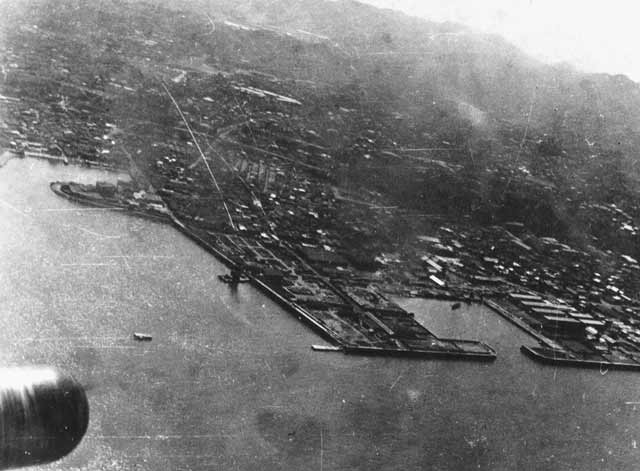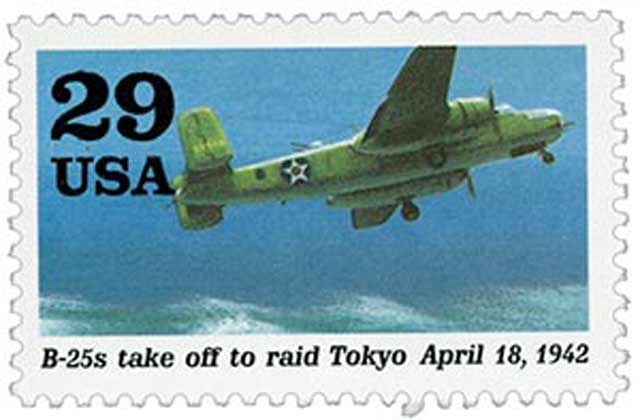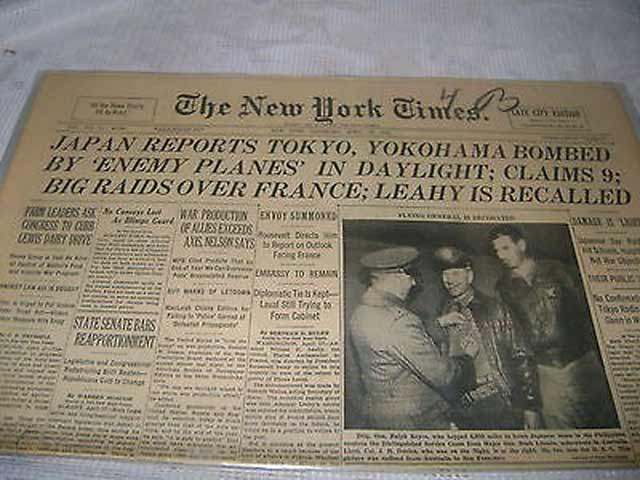Saturday 18 April 1942
 |
| "A B 25 bomber of the US Army Air Force, piloted by Lieutenant Colonel James H Doolittle, takes off from USS HORNET, bound for a raid on Tokyo and other Japanese military centers on 18 April 1942." © IWM NY 7343. |
Battle of the Pacific: Lieutenant-Colonel James H. Doolittle launches his Doolittle Raid on Tokyo on 18 April 1942. While successful in many respects, it does not go exactly as planned. The day is rainy and overcast, with thirty-foot swells and repeated rain squalls.
At 03:00, the USS Enterprise radar operators spot two Japanese picket ships about 11 miles ahead. Admiral "Bull" Halsey sounds general quarters and takes evasive action, which avoids contact for the moment. At 05:58, an Enterprise scout plane spots another patrol boat about 40 miles ahead and flies back to drop this sighting on the Enterprise's deck in a canvas bag in order to maintain radio silence. Halsey again changes course, and again this avoids contact.
At 07:48, a Japanese picket boat (Patrol Boat No. 25, the Nitto Maru) suddenly appears off within sight of aircraft carrier Hornet about ten miles away. US Navy cruiser Nashville opens fire with six-inch guns and Enterprise dive-bombers quickly join in. They sink the Nitto Maru at 08:23, but the Japanese crew has alerted the Fifth Fleet that it has spotted "three enemy carriers." Radio operators on the Enterprise pick up these transmissions and know they have lost the element of surprise. SBD Dauntless and F4F Wildcat planes from the Enterprise also sink patrol boats Iwata Maru No. 1, Nagato Maru, and Nanshin Maru No. 26, with some of their crew rescued by I-74.
 |
| A B-25B bomber taking off from USS Hornet on its way to Japan, 18 April 1942. |
Even though the ships are still about 700 miles east of Japan, Admiral Halsey sends the "go" signal to Doolittle on the Hornet:
launch planes x to colonel doolittle and gallant command x good luck and god bless you.
The pilots know they are too far away from Japan to make it to Chinese bases, as the plan was to close to within 400 miles. At 08:15, Doolittle takes off with the first B-25, barely clearing the waves by yards. The 15 other bombers soon follow, and Halsey quickly orders the task force to reverse course back to Hawaii.
At 09:45, a Japanese patrol plane spots the bombers and alerts Tokyo. However, Japanese naval intelligence believes it is impossible for twin-engined bombers to be operating that far out to sea and takes no action. Doolittle continues leading his force west in a very loose formation stretching over two hundred miles, fighting 20-mile-per-hour headwinds.
 |
| Smoke rises from bomb strikes on the Japanese mainland on 18 April 1942. |
Colonel Doolittle, in the lead, crosses the Japanese coast around noon about 80 miles northeast of Tokyo. At 12:15, he releases four incendiary clusters on the city. Facing heavy antiaircraft fire, Doolittle descends to a treetop level and turns south, heading for China. The following bombers arrive soon after from all directions but skip Tokyo and instead bomb Yokohama, Kobe, Osaka, and Nagoya, confusing the Japanese defenses. After dropping their 500-pound bombs, they, too, scoot off to the west toward China.
The raid demolishes 112 buildings and damages 53 more, killing 87 men, women, and children. There are 151 civilians seriously injured, one being a woman shot through the face and thigh while gathering shellfish near Nagoya. Another 311 Japanese suffer minor injuries. For a single raid by only 16 bombers, the raid causes an outsized amount of damage compared to similar European missions, likely because the Japanese are taken completely by surprise and have not organized any air defenses.
The Doolittle raiders now are in the clear, but they have one problem: they don't have enough fuel to make it to the planned five landing strips at Chuchow. The US has kept the raid so secret, however, that the Chinese haven't been properly informed of the bombers' arrival, so they fail to send out pre-arranged homing signals. In any event, the bombers run out of fuel, and most of the crews bail wherever they happen to be - and many crews can't even tell if they are over land or water due to clouds and fog. Of the sixteen planes, only one makes a safe landing at an airfield at Vladivostok, where, much to their surprise, they are taken imprisoned as internees (they eventually escape to Iran).
Doolittle's plane makes it to a Chinese airfield after dark, but the local authorities mistake his plane for a Japanese bomber and turn off the field lights. Unable to see the field to land, Doolittle and his crew bail as the bomber runs out of fuel. They are aided by local Chinese citizens and eventually make it back to the United States.
 |
| Four unidentified Doolittle Raiders being escorted in a Japanese village, 18 April 1942. |
Doolittle himself parachutes into a rice paddy behind Japanese lines and quickly makes contact with Chinese guerillas. Only three of 72 crewmen of the Doolittle Raiders perish before reaching the ground. Eight men are taken as prisoners and, after a war crimes trial, three are executed by a Japanese firing squad. One of the other men dies in captivity. The planes averaged about 2,250 nautical miles (4170 km), the longest mission ever by B-25 Mitchell bombers. The last surviving crewman, Lt. Robert L. Hite, passes away on 29 March 2015.
The Doolittle Raid isn't the only US Army Air Force raid today. The US 5th Air Force sends Martin B-26 bombers over the Japanese overseas base at Rabaul and hits Japanese Navy aircraft transport Komaki Maru. The ship sinks so close to shore that the Japanese fill the hulk with sand and make it a pier.
 |
| The Minneapolis Morning Tribune of 18 April 1942 trumpets the Doolittle Raid on Tokyo. |
Battle of the Indian Ocean: British troops of the Burma Division are in trouble south of Penangyaung, as Japanese troops have blocked their best escape route to the north. The 13th Indian Brigade launches a breakout attempt at 06:00 that is intended to open a path to advancing Chinese relief forces of General Sun Li-jen's 38th Division.
The ground is rough and well-forested and the Allied attack bogs down without taking its key objective, a hill overlooking a road they can use to escape. The fighting in the dense forest becomes confused and desperate. A small Japanese force feigns being Chinese and lulls troops of the 1st Battalion The Royal Inniskilling Fusiliers into letting down their guard, then suddenly attacks and bayonets the surprised British troops, killing several men. Throughout the day, the Japanese infantry is supported by effective air support.
At 17:00, the Allied troops consolidate and form a defensive perimeter after a hard day of close fighting. Unknown to the British troops, the Chinese relief force makes good progress and crosses the Pin Chaung Ford, brightening the prospects of effective relief. The British plan another breakout attempt on the 19th.
European Air Operations: It is a quiet day on the Channel Front as weather conditions are poor.
Battle of the Atlantic: U-boats have achieved devastating success during Operation Paukenschlag off the east coast of the United States, to the consternation of US authorities. Convoys are planned but have not yet made any difference. In desperation, the US Navy now orders a blackout all along the east coast to prevent U-boats from using city lights to spot the silhouettes of passing ships.
German 2978-ton freighter Seefahrer hits a mine and sinks near Borkum, Germany.
Elsewhere in Burma, the Japanese 55th Division encircles the Chinese 55th Division in the Toungoo area. The Chinese have few prospects for relief. The Japanese 56th Division is battering the Chinese 6th Corps in the Karen Hills area of Bawlake, Bato, Taunggyi, and Loikaw and slowly forcing the Chinese back.
 |
| A U.S. postage stamp commemorating the Doolittle Raid of 18 April 1942. |
Eastern Front: The spring thaw ("Rasputitsa") is in full swing in central Russia, and General Franz Halder notes in his diary, "Unaccountable quiet along the entire front." However, the relief attempt at Demyansk continues with the breakout from the pocket making good progress as well as General Seydlitz's men coming up along the Lovat River.
European Air Operations: It is a quiet day on the Channel Front as weather conditions are poor.
Battle of the Atlantic: U-boats have achieved devastating success during Operation Paukenschlag off the east coast of the United States, to the consternation of US authorities. Convoys are planned but have not yet made any difference. In desperation, the US Navy now orders a blackout all along the east coast to prevent U-boats from using city lights to spot the silhouettes of passing ships.
German 2978-ton freighter Seefahrer hits a mine and sinks near Borkum, Germany.
 |
| The New York Times of 18 April 1942 features the Doolittle Raid as its main headline, along with Admiral Leahy being recalled as Ambassador to France. |
Battle of the Mediterranean: Air raids on Malta resume today after a multi-day lull. A bomber hits and sinks Royal Navy tug HMS Andromeda while the tug is leaving Grand Harbour.
Royal Navy submarine HMS Thrasher torpedoes and sinks 1297-ton German freighter Bellona near Tobruk.
Partisans: On the Nanos Plateau in the Slovene Littoral, about 800 Italian soldiers surround 54 Slovene partisans. In this Battle of Nanos, the Italians kill 10 partisans and capture 11, with the rest escaping in the forest.
Propaganda: General Halder meets with General Dittmar, the army radio spokesman, to discuss how the army "wants news presented."
Finnish/German Relations: General Halder receives the Finnish Cross of Liberation 1st Class from General Talvela.
French Government: Pierre Laval officially returns to power. Not only is he head of the executive, with Petain now a figurehead, he also is Minister of the Interior, of Information and of Foreign Affairs. He pledges to maintain "Une place de choix" (a special place) for France beside Germany in the fight against Communism.
American Homefront: The Toronto Maple Leafs complete one of the greatest comebacks in sports history when they defeat the Detroit Red Wings 3-1 in Game 7 of the Stanley Cup Finals. The Maple Leafs were down 3 games to none but now have won the last four games to win the title. This is Toronto's fourth Stanley Cup.
Partisans: On the Nanos Plateau in the Slovene Littoral, about 800 Italian soldiers surround 54 Slovene partisans. In this Battle of Nanos, the Italians kill 10 partisans and capture 11, with the rest escaping in the forest.
 |
| Hitler Youth marching on 18 April 1942 (Federal Archive Image 183-J01182). |
Finnish/German Relations: General Halder receives the Finnish Cross of Liberation 1st Class from General Talvela.
French Government: Pierre Laval officially returns to power. Not only is he head of the executive, with Petain now a figurehead, he also is Minister of the Interior, of Information and of Foreign Affairs. He pledges to maintain "Une place de choix" (a special place) for France beside Germany in the fight against Communism.
American Homefront: The Toronto Maple Leafs complete one of the greatest comebacks in sports history when they defeat the Detroit Red Wings 3-1 in Game 7 of the Stanley Cup Finals. The Maple Leafs were down 3 games to none but now have won the last four games to win the title. This is Toronto's fourth Stanley Cup.
Gertrude Vanderbilt Whitney passes away in New York City at age 67. She is the founder of the Whitney Museum of American Art. She also is the designer of the Titanic Memorial in Washington, D.C.
Future History: The last surviving Doolittle raider, Lt. Col. Richard Cole, dies on 9 April 2019. Mission commander Jimmy Doolittle’s co-pilot, Cole parachuted out of his B-25 as it was running out of gas and spent the night in a tree before some locals reunited him with Doolittle.
April 2, 1942: Doolittle Raiders Leave Port
April 3, 1942: Japanese Attack in Bataan
April 4, 1942: Luftwaffe Attacks Kronstadt
April 5, 1942: Japanese Easter Sunday Raid on Ceylon
April 6, 1942: Japanese Devastation In Bay of Bengal
April 7, 1942: Valletta, Malta, Destroyed
April 8, 1942: US Bataan Defenses Collapse
April 9, 1942: US Defeat in Bataan
April 10, 1942: The Bataan Death March
April 11, 1942: The Sea War Heats Up
April 12, 1942: Essen Raids Conclude Dismally
April 13, 1942: Convoy QP-10 Destruction
April 14, 1942: Demyansk Breakout Attempt
April 15, 1942: Sobibor Extermination Camp Opens
April 16, 1942: Oil Field Ablaze in Burma
April 17, 1942: The Disastrous Augsburg Raid
April 18, 1942: The Doolittle Raid bombs Japan
April 19, 1942: British in Burma Escape
April 20, 1942: The Operation Calendar Disaster
April 21, 1942: Germans Relieve Demyansk
2021
April 1942
April 1, 1942: Convoys Come to the USAApril 2, 1942: Doolittle Raiders Leave Port
April 3, 1942: Japanese Attack in Bataan
April 4, 1942: Luftwaffe Attacks Kronstadt
April 5, 1942: Japanese Easter Sunday Raid on Ceylon
April 6, 1942: Japanese Devastation In Bay of Bengal
April 7, 1942: Valletta, Malta, Destroyed
April 8, 1942: US Bataan Defenses Collapse
April 9, 1942: US Defeat in Bataan
April 10, 1942: The Bataan Death March
April 11, 1942: The Sea War Heats Up
April 12, 1942: Essen Raids Conclude Dismally
April 13, 1942: Convoy QP-10 Destruction
April 14, 1942: Demyansk Breakout Attempt
April 15, 1942: Sobibor Extermination Camp Opens
April 16, 1942: Oil Field Ablaze in Burma
April 17, 1942: The Disastrous Augsburg Raid
April 18, 1942: The Doolittle Raid bombs Japan
April 19, 1942: British in Burma Escape
April 20, 1942: The Operation Calendar Disaster
April 21, 1942: Germans Relieve Demyansk
No comments:
Post a Comment